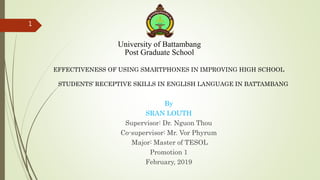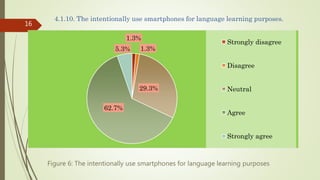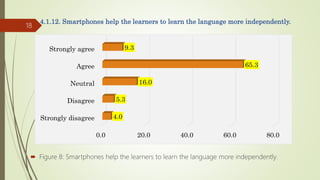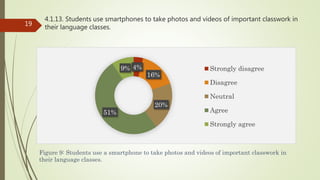Sran louth thesis 2018 defending slide
- 1. University of Battambang Post Graduate School EFFECTIVENESS OF USING SMARTPHONES IN IMPROVING HIGH SCHOOL STUDENTSŌĆÖ RECEPTIVE SKILLS IN ENGLISH LANGUAGE IN BATTAMBANG By SRAN LOUTH Supervisor: Dr. Nguon Thou Co-supervisor: Mr. Vor Phyrum Major: Master of TESOL Promotion 1 February, 2019 1
- 2. Chapter 1 Introduction 1.1 Background and Rationale ’āś Education is really important for all developed and developing countries. ’āś The spread and advancement of English language around the globe, English is utilized as universal language. ’āś The status of English in Cambodia is higher than any other time as is confirmed by its situation. ’āś Learning English is essential for students , so to improve English language students have many choices to do it. ’āś Smartphones are one way to help students with language learning facility. 2
- 3. ’é┤ Smartphones are very popular with the language learners. ’é┤ Smartphones are the best devices for checking new words, recording the information, learning practice and especially for helping students to do their homework or assignments. ’é┤ Smartphones are ending up more mainstream these days for students whether higher learning students or low-level students have been using the smartphones to assist their learning by utilizing numerous applications which are found on smartphones. ’é┤ They download and run various applications with the smartphones even with or without an Internet connection.
- 4. 1. 2 Research Question ’é┤ Do smartphones really help students to improve their receptive skills? 1.3 Hypothesis ’é┤ Students who study at high school in Battambang Town have mainly used smartphones to support their study. 1.4 Research objectives 1.4.1 Main Objective ’é┤ The main objective of this thesis is to explore the effectiveness of using smartphones in improving studentsŌĆÖ receptive skills (reading and listening). 1.4.2 Specific objectives ’é┤ To identify the effectiveness of using smartphones for helping studentsŌĆÖ receptive skills in learning the English language in high school. ’é┤ To explore the role of the smartphones to support studentŌĆÖs receptive skills in learning the English language. ’é┤ To explore how the use of smartphones affect studentsŌĆÖ motivation to learn and engagement in learning the English language with receptive skills. 4
- 5. 1.5 Significance of this study This research will be useful for: ’üČMinistry of Education. ’üČEducational institutions ’üČAcademic researchers, educators and learners 1.6 Limitation and scope of the study ’é┤ This research was conducted three high schools in Battambang town. ’é┤ Sample was limited and selected from grade 10, 11, and 12 in each high school. ’é┤ This research time bound was just only six months. 5
- 6. CHAPTER 2 LITERATURE REVIEW This review focuses on research about the effectiveness of using smartphones in improving high school studentŌĆÖs receptive skills in English language. ’üČ Effectiveness, smartphones and receptive skills have been defined variously according to different authors. ’é¦ The term "effectiveness " refers to how many goals are accomplished and the degree to which focused issues are comprehended. ’é¦ Rather than productivity, effectiveness is resolved without reference to costs and, while proficiency signifies "doing the thing right," viability signifies "making the best choice." (Hersey & Blanchard, 2018). ’é¦ According to the Cambridge dictionary, the term effectiveness refers to the capacity to be fruitful and to create the proposed results (Cambridge, 2018). 6
- 7. ’é┤ The term smartphones indicate a phone that can be utilized as a little PC and that connects to the web (Cambridge dictionary, 2018) ’é┤ The significance from smartphones refers to the processing smartphones with PC includes that may empower it to cooperate with electronic frameworks, send messages, and access the web (Collins dictionary, 2018). ’é┤ As indicated by dictionary.com the word smartphone refers to a gadget that joins the smartphones with a handheld PC, ordinarily offering the Web, information stockpiling, email, online life, capacity, and etc. (Dictionary.com, 2018). 7
- 8. ’é┤ Receptive Skills refers to listening and reading since students don't have to create language to do these, they get and comprehend it (British Council, 2018). ’é┤ Students use smartphones as beneficial for the language learning (Yaman, Senel, & Yesilel, 2015). ’é┤ Smartphones effect on language learning and they are the source to process English language learners (Muhammed, 2014). ’é┤ The language which students used smartphones to study vocabulary, they could improve and achieve their learning vocabulary by using a smartphone (Wu, 2014). ’é┤ Language learners used their smartphones with applications for learning (Ben, Andrew, & Anne, 2012). 8
- 9. 3.1 Research Location Conducted in three public high schools in Cambodia which is located in Battambang town. 9 Research Location Research Location Research Location
- 10. 3.3 Sampling size and Sampling Methods ’āś Sample size: Use the stratified sampling technique 75 respondents Sampling methods: -the quota, a non-probability sampling technique, was used to divide the sample into 3 groups equally 3.4 Questionnaire ’é┤ Questionnaire: Close ŌĆōended and Open-ended question with 75 students 10
- 11. 3.5 Data Collection ’é┤ Primary Data: collected by doing a survey with the 75 respondents ’é┤ Secondary Data: gathered from many importance sources such as the previous soft, Journals and international researchers ’é┤ 3.6 Data Analysis Quantitative data were analyzed by ’āś summary ’āś categorize ’āś use excel ’āś SPSS with frequency, percentage and multiple response 11
- 12. 4.1 Information of the participants ’é┤ The respondents were randomly selected from three high schools in Battambang town. ’é┤ All of them are studying in grade 10, 11 and 12 ’é┤ Male : 49.3 % ’é┤ Female: 50.7% ’é┤ The age of the respondents: - Under 15 (4%) - Between 15-16 ( 54.7%) - Between 17-18 (37.3%). - Over 18 (4%) 12 CHAPTER 4 RESULT AND DISCUSSION
- 13. 13 Android 57.9% iphone IOS 38.2% Window phone 2.6% Blackberry 1.3% Android iphone IOS Window phone Blackberry Figure 3: Kinds of smartphones use of the respondents 4.1.5. Kind of smartphones use of the respondents
- 14. 14 Time which students spent on their reading and listening in the English language Reading Listening Frequency Percent Frequency Percent 30-60 minutes a day 39 52.0 35 46.7 1-2 hours a day 27 36.0 31 41.3 2-3 hours a day 9 12.0 6 8.0 3-4 hours a day 0 0 3 4.0 Total 75 100% 75 100% Table 4: Time which students spent on reading and listening on their smartphone.
- 15. 15 0.0 10.0 20.0 30.0 40.0 50.0 60.0 70.0 80.0 Strongly disagree Disagree Neutral Agree Strongly agree 4% 1.3% 17.3% 70.7% 6.7% Figure 5: The advent of smartphones has contributed significantly to the respondentŌĆÖs English language learning process. 4.1.9. The advent of smartphones has contributed significantly to the respondentŌĆÖs English language learning process
- 16. 16 Figure 6: The intentionally use smartphones for language learning purposes 1.3% 1.3% 29.3% 62.7% 5.3% Strongly disagree Disagree Neutral Agree Strongly agree 4.1.10. The intentionally use smartphones for language learning purposes.
- 17. ’é┤ Figure 7: The use of the voice recorder or smartphone to record the lessons and be able to listen to them at a later time. 17 2.7 8.0 18.7 57.3 13.3 0.0 10.0 20.0 30.0 40.0 50.0 60.0 70.0 Strongly disagree Disagree Neutral Agree Strongly agree 4.1.11. The use of the voice recorder of a smartphone to record the lessons and be able to listen to them at a later time.
- 18. ’é┤ Figure 8: Smartphones help the learners to learn the language more independently. 18 0.0 20.0 40.0 60.0 80.0 Strongly disagree Disagree Neutral Agree Strongly agree 4.0 5.3 16.0 65.3 9.3 4.1.12. Smartphones help the learners to learn the language more independently.
- 19. 4.1.13. Students use smartphones to take photos and videos of important classwork in their language classes.19 4% 16% 20% 51% 9% Strongly disagree Disagree Neutral Agree Strongly agree Figure 9: Students use a smartphone to take photos and videos of important classwork in their language classes.
- 20. 4.1.14. Smartphones improve access to studentsŌĆÖ courses and learning material. 20 0.0 10.0 20.0 30.0 40.0 50.0 Strongly disagree Disagree Neutral Agree Strongly agree 4% 10.7% 28% 45.3% 12% Figure 10: Smartphones improve access to studentsŌĆÖ courses and learning material
- 21. 4.1.15. Using smartphones for looking up unknown lexical items from the dictionary. 21 0.0 20.0 40.0 60.0 1.3% 1.3% 2.7% 53.3% 41.3% Strongly disagree Disagree Neutral Agree Strongly agree Figure 11: Using smartphones for looking up unknown lexical items from the dictionary
- 22. 4.1.17. Having a smartphone enables learners to learn English whenever and wherever they want without any limitation.22 0.0 10.0 20.0 30.0 40.0 50.0 60.0 70.0 Strongly disagree Disagree Neutral Agree Strongly agree 1.3 4.0 14.7 62.7 17.3 Figure 13: Percentage of the studentsŌĆÖ using their smartphone to learn the English language whenever and whenever they want without any limitation.
- 23. 4.1.21. Using smartphones to help develop reading, listening and other skills. 23 0 10 20 30 40 50 60 70 80 Reading Listening Other skills 0 1.3 4.01.3 1.3 4.0 17.3 20.0 33.3 72.0 69.3 52.0 9.3 8.0 6.7 Strongly disagree Disagree Neutral Agree Strogly agree Figure 16: Smartphones helps to develop reading, listening and other skills
- 24. 24 Table 7: Using smartphones outside the classroom for the purpose of studying the English language. The rating scale of Using smartphones learn outside of the classroom Using smartphones for the purpose of the study Using part of smartphones to improve reading and listening in the English language. the respondents Frequency Percent Frequency Percent Frequency Percent Strongly disagree 2 2.7 0 0 2 2.7 Disagree 5 6.7 2 2.7 2 2.7 Neutral 9 12.0 23 30.7 14 18.7 Agree 50 66.7 44 58.7 53 70.7 Strongly agree 9 12.0 6 8 4 5.3 Total 75 100.0 75 100 75 100.0
- 25. 4.1.24. The smartphone is a real assistant to students with their assignments, homework in reading and listening. 25 1.3 1.3 26.7 54.7 16.0 0.0 10.0 20.0 30.0 40.0 50.0 60.0 Strongly disagree Disagree Neutral Agree Strongly agree Figure 18: Smartphone is a real assistant to students with their assignments, homework in reading and listening
- 26. 4.1.26. The rating scale of using smartphones for helping students in improving their English language. 26 Questions Q.3.22 Q.3.23 Q.3.24 Q.3.25 Q.3.26 N Valid 75 75 75 75 75 Missing 0 0 0 0 0 Mean 3.57 3.59 3.73 3.67 3.79
- 27. 27 4.1.27. Many apps available on smartphones help strengthen students listening and reading in the English language. Strongly disagree Disagree Neutral Agree Strongly agree Percentage 1.3 1.3 28.0 58.7 10.7 1.3 1.3 28.0 58.7 10.7 0.0 10.0 20.0 30.0 40.0 50.0 60.0 70.0 Figure 20: Many apps available on smartphones help strengthen students listening and reading in the English language.
- 28. 4.1.28. Whether smartphones help students to increase their English language or not. 97.3% 2.7% Yes No Figure 21: Whether smartphones help students to increase their English language or not.
- 29. 4.1.29. Use smartphones to improve listening with the English language. 93.3% 6.7% 0.0 20.0 40.0 60.0 80.0 100.0 Yes No Figure 22: Use smartphones to improve listening with the English language
- 30. 4.1.30. Use smartphones to improve reading with the English language. 62.7% 37.3% 0.0 10.0 20.0 30.0 40.0 50.0 60.0 70.0 Yes No Figure 23: Use of smartphones to improve reading with the English language.
- 31. Questions Q4.31 Q4.32 Q4.33 Q4.34 Q4.35 Q4.36 N Valid 75 75 75 75 75 75 Missing 0 0 0 0 0 0 Mean 1.07 1.32 1.07 1.16 1.11 1.05 Median 1.00 1.00 1.00 1.00 1.00 1.00 Mode 1 1 1 1 1 1 Std. Deviation .251 .470 .251 .369 .311 .280 Table 9: Effectiveness of using smartphones to support English language learning.
- 32. 4.1.36. Using smartphones for supporting receptive skills. 10.7 22.7 33.3 21.3 9.3 2.7 0.0 5.0 10.0 15.0 20.0 25.0 30.0 35.0 Always Normally Often Sometimes Seldom Never Figure 26: Using smartphones for helping receptive skills.
- 33. Google translate search documen ts socical media like face book, watch youtube. check dictionar y other research listening reading writing percentage 19 60 70 73 50 60 50 45 19% 60% 70% 73% 50% 60% 50% 45% 0 10 20 30 40 50 60 70 80 4.1.39. Ways which students used smartphones to improve their English language. Figure 29: Ways which students used smartphones to improve their English language
- 34. 4.4 Discussion ’é┤ The results of the research, the high percentage of the respondents who agreed that the advent of smartphones has contributed significantly to English language learning process was 70.7%. ’é┤ The study found that 62.7% of the respondents used smartphones for language learning purposes. ’é┤ 72.1% of the students used smartphones for helping them when doing their assignments or homework. ’é┤ 97.3% used smartphones to improve English language. ’é┤ 99% of the students considered the smartphones as an effective source to process their English language learning (Muhammed, 2014). ’é┤ The study in Turkey which indicated that 68% used it to record the lessons and listened to them later (Yaman, Senel, & Yesilel, 2015). ’é┤ 76% used the applications from the smartphones for learning (Woodcock, Middleton, & Nortcliffe, 2012). ’é┤ 93.3% of the students used smartphones in order to improve their listening and 62.7% of them used the smartphones for reading the texts in English simlare the study from Muhammad, 2014 illustrated that all the students used the smartphones to support their language learning 99% 34
- 35. CHAPTER 5 CONCLUSION AND RECOMMENDATIONS 5.1 Conclusion ’āś the result of the study showed that using smartphones help students to improve their English language learning process was 70.7% ’āś The result indicated that 52% of the students used smartphones for reading the texts and 46.7% of them used smartphones for improving listening from thirty to sixty minutes a day ’āś 62.7% of the students agreed that the smartphones are undoubtedly among the most important tools in term of access to information in English learning. ’āś 72% of the respondents use smartphones to improve their reading and 69.3% use them to improve their listening. ’āś The last objective of this study illustrated that using smartphones motivate students to learn the English language as the result showed that 66.7% of the students can develop their English by using the smartphones. 35
- 36. 5.2 Recommendations ’é┤ 5.2 Recommendation ’é┤ Schools should allow students to use smartphones in classroom learning a language with the set of the rule of using in order to help them when learning the English language. ’é┤ Teachers should guide studentsŌĆÖ ways of using smartphones in effective ways of learning the English language. ’é┤ Parents should allow their children to use smartphones at high school because the smartphones are the best material for helping them to learn the language in this century. ’é┤ Students should use smartphones in the right ways of learning the language. 36
- 37. Recommendation for the next researchers ’é┤ The effectiveness of using smartphones in improving studentsŌĆÖ productive skills in learning the English language at high school, therefore, the researchers should conduct this topic with the high schools in the city and districts in Cambodia. ’é┤ The advantages of using smartphones enhance students in learning the English language in the 21st century, hence, the researchers should conduct this topic research with students who study at the university. ’é┤ The role of smartphones support students at a university in learning and doing the assignments. The researchers should conduct this topic research with two or three universities. 37
- 38. Thanks You 38






































